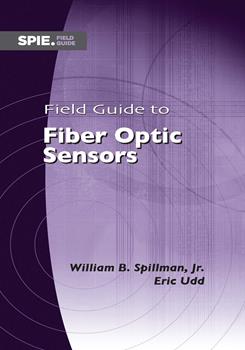|
|
BibliographyBelkerdid M. A., Ghandeharioun N., Brennan B., ““Fiber optic fluid level sensor,”,”153–158 (1986). Google Scholar
Berthold J. W. et al., ““Design and Characterization of a High Temperature Fiber-Optic Pressure Transducer,”,” J. Lightwave Technol., 5 (7), 870 (1987). Google Scholar
Bosselmann T. et al., ““Fiber optic temperature sensor using fluorescence decay time,”,”(1984). Google Scholar
Burns W. K., Optical Fiber Rotation Sensing, Academic Press, Boston
(1994). Google Scholar
Claus R., Rogowski R. S., (1992). Google Scholar
Culshaw B., Dakin J., Optical Fibre Sensors, I, II, III, and IV 1988–1996 Artech House, Boston Google Scholar
Du H. H., Pickrell G., Udd E., Baldwin C. S., Benterou J. J., Wang A., (2014). Google Scholar
DePaula R., Berthold J., (1996). Google Scholar
Glisic B., Inaudi D., Fibre Optic Methods for Structural Monitoring, John Wiley & Sons, New York
(2007). Google Scholar
Hutley M. C., Diffraction Gratings, Academic Press, London
(1982). Google Scholar
Kersey A. D., ““A Review of Recent Developments in Fiber Optic Sensor Technology,”,” Opt. Fiber Technol., 2 (3), 291–317 (1996). Google Scholar
Kingston R. H., Detection of Optical and Infrared Radiation, Springer-Verlag, Berlin
(1978). Google Scholar
Kirchhoff G., ““On the relation between the radiating and absorbing powers of different bodies for light and heat,”,” Annalen der Physik, 109 275 (1860). Google Scholar
LaClair R. D., Spillman W. B., Kuhns W. W., ““Long stroke optical fiber linear position sensor for the FLASH program,”,”137–141 (1996). Google Scholar
Lagakos N. et al., ““Microbend fiber-optic sensor,”,” Appl. Opt., 26 (11), 2171 (1987). Google Scholar
Liu J. N. et al., ““Development of a porous polymer pH optrode,”,” Opt. Lett., 17 (24), 1815 (1992). Google Scholar
López-Higuera J. M., Handbook of Optical Fibre Sensing Technology, John Wiley & Sons, New York
(2002). Google Scholar
López-Higuera J. M., Jones J., Lopez-Amo M., Santos J. L., 1998–2014 Google Scholar
Mendez A., Morse T. F., Specialty Optical Fibers Handbook, Academic Press, Amsterdam
(2007). Google Scholar
Saleh B. E. A., Teich M. C., Fundamentals of Photonics, John Wiley & Sons, New York
(1991). Google Scholar
Scott G. B., Lacklison D. E., ““Magnetooptic Properties and Applications of Bismuth Substituted Iron Garnets,”,” IEEE Trans. Magnetics, 12 (4), 292 (1976). Google Scholar
Spillman W. B., ““Multimode fiber-optic hydrophone based on a Schlieren technique,”,” Appl. Opt., 20 (3), 465 (1981). Google Scholar
Spillman W. B., ““The evolution of smart structures/materials,”,”97 (1992). Google Scholar
Spillman W. B., McMahon D. H., ““Frustrated-total-internal-reflection multimode fiber-optic hydrophone,”,” Appl. Opt., 19 (1), 113–117 (1980). Google Scholar
Spillman W. B., McMahon D. H., ““Multimode fiber optic hydrophone based on the photoelastic effect,”,” Appl. Opt., 21 (19), 3511 (1982). Google Scholar
Spillman W. B., McMahon D. H., ““Multimode fiber optic sensors based on the photoelastic effect,”,”110–114 (1983). Google Scholar
Spillman W. B., Rudd R. E., ““Enhanced performance Faraday sensor,”,”294–304 (1993). Google Scholar
Spillman W. B., Patriquin D. R., Crowne D. H., ““Fiber optic linear displacement sensor based upon a variable period diffraction grating,”,” Appl. Opt., 28 (17), 3550 (1989). Google Scholar
Spillman W. B., ““A ‘smart’ bed for non-intrusive monitoring of patient physiological factors,”,” J. Meas. Sci. Technol., 15 (8), 1614 (2004). Google Scholar
Spillman W. B., ““Statistical mode sensor for fiber optic vibration sensing applications,”,” Appl. Opt., 28 (15), 3166 (1989). Google Scholar
Theocaris P. S., Gdoutos E. E., Matrix Theory of Photoelasticity, Springer-Verlag, Berlin
(1979). Google Scholar
Udd E., ““An overview of fiber optic sensors,”,” Rev. Sci. Instruments, 66 (8), 4015 (1995). Google Scholar
Udd E., ““Fiber optic smart structures,”,”884–894 (1996). Google Scholar
Udd E., Fiber Optic Smart Structures,, John Wiley & Sons, New York
(1995). Google Scholar
Udd E., Spillman W. B., Fiber Optic Sensors: an Introduction for Engineers and Scientists,, 2nd Ed.John Wiley & Sons, Hoboken, NJ
(2011). Google Scholar
Villarruel C. A., ““Evanescent wave fiber optic chemical sensor,”,”225–229 (1987). Google Scholar
Yariv A., Introduction to Optical Electronics,, 2nd Ed.Holt, Rinehart and Winston, New York
(1976). Google Scholar
Yin S., Ruffin P. B., Yu S. F. T., Fiber Optic Sensors, 2nd Ed.CRC Press, Boca Raton, FL
(2008). Google Scholar
Udd has 48 issued US Patents, with additional applications pending. He has written over 150 papers, chaired more than 30 international conferences on fiber sensors, edited textbooks, and contributed many book chapters. He is a McDonnell Douglas Fellow, an SPIE Fellow, and an OSA Fellow. He was awarded the David Richardson Medal by OSA in 2009 for his work on fiber optic sensors and the field of fiber optic smart structures. |
CITATIONS




